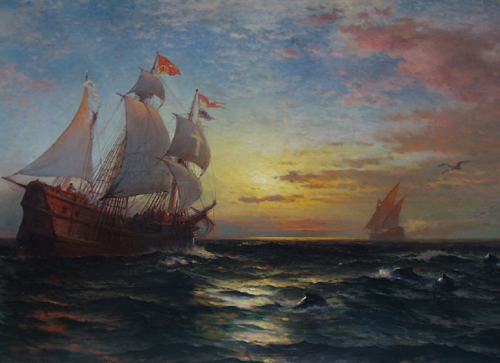
Presentation Title: Harvesting the Wind at Sea: Evolution of Sailing Vessels from Ancient Seafaring to the Twentieth Century
Speaker: Dr. David Switzer, LAMP Research Associate and Professor Emeritus of History at Plymouth State University
When: Wednesday, November 3rd, 7:00 to 8:00 pm
Where: Anastasia Galley (upstairs in Keepers’ House), St. Augustine Lighthouse & Museum
Free and open to the public!
Harvesting the Wind at Sea: Evolution of Sailing Vessels from Ancient Seafaring to the Twentieth Century
Lecture by Dr. David Switzer, LAMP Research Associate and Professor Emeritus of History at Plymouth State University Wednesday, November 3, 2010, 7:00 pm, Anastasia Gallery, St. Augustine Lighthouse & Museum
In 3100 BC the first sails were depicted on drawings of boats navigating on the Nile River. Soon sails on larger vessels facilitated voyages along the coast of the Near East. By 1200 BC rudimentary sails were depicted on carvings of Minoan vessels to be followed by venturesome Phoenician traders who exited the Mediterranean to the Atlantic via the Strait of Gibralter. Meanwhile Greeks and then Romans plied the Aegean and the Mediterranean in sail driven freighters and warships. The first Age of Sail had arrived.
The second Age of Sail ,c.15th and 16th centuries, which was accompanied by new vessel types, saw the “marriage” of two shipbulding techniques, one from the Mediterranean and the other originated in the Baltic. The Baltic contribution was a one masted vessel carrying a square sail and a transom mounted rudder; it was related to earlier Norse of Viking craft. The Mediterranean contibution featured multiple masts with triangular or lateen sails. The “marriage” produced what has been identified as the full rigged ship, with three masts carrying square sails.
The appearance of the full rigged ship launched the third Age of Sail, 17th century to early 19th century, that saw galleons, long distance cargo carrying vessels, and advancements in naval construction.
The fourth and best known Age of Sail was a 19th into the early 20th century period that saw “the search for speed under sail”. The Atlantic packet ships were the “scene setters” followed by the better known clipper ship era. The American invented clippers had short careers affected by the inroads of steam navigation and a financial panic followed by the Civil War. During this age wind dependent grew larger in the form of “Downeasters” and iron or steel wind jammers known as “Cape Horners”. Their cargos were predominately grain and nitrates (guano).Beset by steam powered freighter and liners,losses to German submarines during World War I and a different world economic environment between the World Wars ended the last Age of Sail,the forbears of which extended back to the ancient Mediterranean.
About the Speaker: A true pioneer in the field of nautical archaeology, Dave Switzer grew up in Maine and graduated from the University of Maine with a BA in history and received an MA and PhD in history from the University of Connecticut. He retired from Plymouth State University (formerly Plymouth State College) in 2004 after a thirty-nine year career as a professor of history and recognized as a Distinguished Teacher. Since 1980 he has served as the Consulting Nautical Archaeologist for the State of New Hampshire. In that capacity he has directed a number of nautical and maritime archaeological projects including the excavation of a 17th century shallop-type vessel, the famed Revolutionary War privateer Defence, the remains of a unique bridge constructed by a Shaker community, and an investigation and documentation of a early 20th century lake steamer. Dr. Switzer is also the author of “The Defence Project in The Archaeology of Ships of War vol. II, M. Bound ed. 2001 and “Excavating a Colonial Privateer” in Beneath the Seven Seas, George Bass, ed. 2005.

